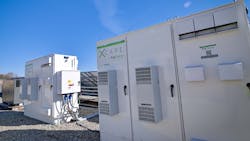Harnessing renewable power: The benefits of distributed energy resources
The world is becoming increasingly concerned about its continued reliance on the traditional power grid, the use of fossil fuels, and their environmental impact. Companies are turning to renewable solutions that generate their own energy as a result, and distributed energy resources (DERs) are gaining momentum in this movement. Global brands such as IKEA, Google, and Apple, as well as smaller companies around the country, are using DERs to save money on energy usage, increase power reliability, and/or invest in sustainability.
This article provides guidance for deciding how distributed energy resources may fit best into new and existing buildings and meet current and future energy needs. Read on to learn about when to use DERs, as well as the benefits that come with integrating them.
So, what are distributed energy resources and how can you determine if distributed energy is right for your facilities?
Distributed Energy Resources (DERs)
Distributed energy resources encompass the technology and systems needed to enable greater flexibility, control, and integration of power. This includes the generation and/or storage of energy at or near the point of use (decentralized resources serving nearby loads). This can include solar, wind, combined heat and power, etc. and be in tandem with battery storage or generators. DERs can work alongside traditional power from the utility grid or operate independently.
Building managers that aim to create net-zero or more energy-efficient and eco-friendly facilities can consider using several different distributed energy resources to generate electricity from sources such as solar, wind, combined heat and power (CHP), or renewable natural gas
Solar and wind energy generation
Solar panels and wind are popular choices for generating renewable energy. Solar panels can be ground mounted or installed on rooftops or facades to capture energy from the sun and convert it to electricity. Wind installation tends to be more site-specific to take advantage of wind profiles dependent on geographical attributes like elevation, terrain, and availability of land
Solar and wind power can reduce a facility’s reliance on traditional energy grids and save companies significant amounts on energy bills; however, on their own, they aren’t always the most constantly available due to their inherent variability. When coupled with battery storage to create a microgrid, excess energy generated during peak sunlight hours or when winds are strong can be stored to use when these resources are not available, decreasing grid usage even further and increasing power resilience.
Microgrids
When it comes to generating, storing, and controlling clean energy, experts will use the term microgrid. Microgrids are a popular energy solution for several reasons, including their resilience, their ability to control energy costs, to bring power to remote regions and to produce and store on-site renewable energy.
There are two requirements for a distributed energy resource to be considered a microgrid:
- It needs to utilize a decentralized, distributed energy source; an example of this would be solar power with battery storage.
- It must be able to operate without the grid present; this is referred to as “island mode.” This means supplemental renewable energy sources such as solar panels or wind are only considered a microgrid if they can disconnect from the traditional power grid and still provide power if needed.
Microgrids can function in conjunction with the traditional electrical grid (grid-tied) or independently from the grid (off-grid). Let’s dive into the numerous benefits both offer and how they can help you meet your cost, resilience and/or sustainability goals.
Grid-tied microgrids
Grid-tied distributed energy systems are connected to the traditional utility grid and work to supplement electricity provided by the grid. For comparison, a traditional distributed energy resource with a similar resiliency function is a generator; however, they are not the most sustainable or reliable options since they traditionally burn fossil fuels and only run for certain timeframes before they need care and maintenance.
Grid-tied renewable energy microgrids, on the other hand, are sustainable and reliable. They cut down on energy costs from the main utility grid by monitoring peak demand (when utility costs are highest) and use renewable resources (sun, wind, etc.) and battery storage for a reliable power source, should the main utility go out.
How does a grid-tied microgrid work?
Microgrids have an intelligent network built into them that can manage fluctuations in power output and demand. Grid-tied systems can operate using renewable power that’s generated during the day and can also pull power from the grid when needed if the sun isn’t shining. Excess energy generated can also be stored in the microgrid’s battery storage system. This is helpful if the power goes out, or if there is a time of day when the building utilizes more power, and a company wants to avoid peak demand charges. If the company is looking to save on energy costs, the microgrid can provide sustainable power during these peak energy usage times and help offset traditional power costs, lowering their energy bill over time.
Additionally with a grid-tied distributed energy microgrid system, in some instances, excess energy generated by solar panels or other renewable sources can also be supplied back to the utility grid. Grid-tied systems can allow companies to use the energy supplied to the utility grid as a form of credit, which can then be used to offset the energy consumed from the utility grid later.
When to use a grid-tied microgrid
There are many reasons why facility managers should consider broadening their building’s energy sources to include grid-tied microgrids, including:
- Increased power reliability. Grid-tied microgrid systems can ensure a company will always have a reliable power source. For example, if a power outage occurs due to a major storm and a grocery store loses power, the store could face major inventory loss if it doesn’t have the power to keep the freezers and refrigeration systems running. Having a backup power system is critical. While a traditional generator could keep the cooling systems running, it is burning fossil fuels that are not environmentally friendly and could run out after a certain amount of time. A more reliable option is a solar-powered microgrid with battery storage to supply power to the refrigeration and freezer units, keeping them running even though the main utility grid is down. For additional resilience, a renewable natural gas generator can be added as a last resort, in case the sun isn’t shining, and the batteries are low on energy storage. A grid-tied microgrid is a great asset in ensuring a company always has a reliable power source.
- Reduce energy costs. One significant advantage of a grid-tied distributed energy system is that it can reduce a building’s energy costs significantly. This is especially important in areas where electricity costs are high and there is easy access to a main utility grid. Places such as major metro areas typically have high demand or time-of-use charges for electricity, leading to higher electricity costs. By generating renewable power, facility managers can avoid paying peak electricity usage prices from utilities and in some cases, revenue can be earned by selling excess power back, as outlined earlier in this article. In addition, both grid-tied and off-grid distributed energy systems are environmentally friendly due to their use of renewable energy sources like wind and solar power. If a company has sustainability goals in place, adding a distributed energy microgrid to the mix can help them achieve their goals.
- Flexibility and scalability. Grid-tied microgrids are also very flexible and provide room for growth as a facility’s power demand grows. For example, solar panels or wind can be added to increase the amount of power generated, a generator can be added if additional resilience is needed, and in some cases, batteries can be added to increase storage capabilities.
Off-grid microgrids
As their name implies, off-grid microgrids are completely disconnected from the utility grid and are designed to operate independently with the use of energy generation and energy storage. There are several major differences between grid-tied and off-grid distributed energy systems.
The upfront costs of off-grid microgrids vary based on an organization’s energy needs; however, they begin to pay for themselves immediately through the money saved by not purchasing power from the utility. They are a reliable power source based on energy generated by renewable resources, such as solar or wind, with excess power stored via battery for usage at night or on a day when the sun or wind are not providing adequate power.
When to use an off-grid microgrid
Off-grid microgrids solve a number of problems that make them ideal in certain applications, including:
- Remote locations. Off-grid microgrids are ideal for remote locations where access to the utility grid is not available or the traditional electric grid is not reliable. Powered solely by renewable energy resources, solar panels can be installed in nearly any area with average sunlight. Off-grid systems powered by wind or fuel cells are alternatives for areas where those resources are more readily available.
- Energy independence and security. Another advantage of off-grid distributed energy microgrid systems is greater energy independence and security. In the event of natural disasters or power outages, centralized power grids and anything connected to them are vulnerable to losing power. Off-grid systems continue to generate and store power as long as their power-generating equipment (solar panels, wind turbines) remains undamaged, creating resilience in places prone to natural disasters such as earthquakes, storms, or wildfires. In addition, off-grid systems are not regulated by utility companies whose pricing policies can vary, providing greater pricing autonomy and control.
Distributed energy resources at your organization
Using distributed energy resources can reduce your organization’s carbon footprint, lower dependence on traditional energy sources, save on operating costs, and improve operational reliability. Embracing the transition to distributed energy resources provides benefits not only from cost-savings, but also contributes to a cleaner, healthier world for future generations. With a thorough understanding of these resources, you can make an informed decision when choosing to integrate distributed energy into your buildings.
About the Author

Dan Nordloh
Dan Nordloh is a senior vice president and general manager at EnTech Solutions, a Faith Technologies Inc. company based in Menasha, Wis.
